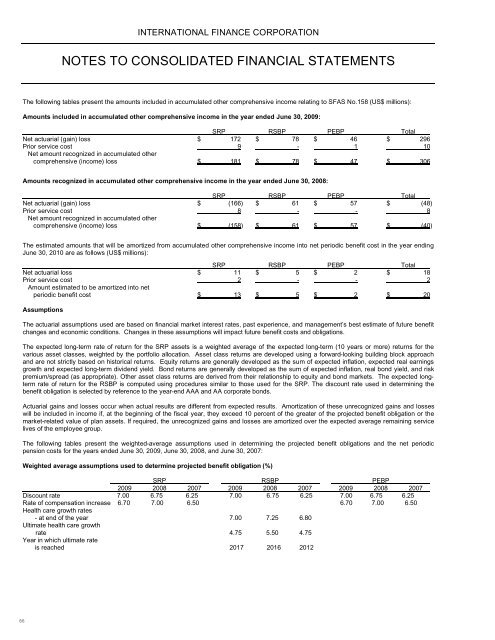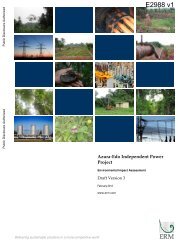Volume 2 - IFC
Volume 2 - IFC
Volume 2 - IFC
You also want an ePaper? Increase the reach of your titles
YUMPU automatically turns print PDFs into web optimized ePapers that Google loves.
INTERNATIONAL FINANCE CORPORATION<br />
NOTES TO CONSOLIDATED FINANCIAL STATEMENTS<br />
The following tables present the amounts included in accumulated other comprehensive income relating to SFAS No.158 (US$ millions):<br />
Amounts included in accumulated other comprehensive income in the year ended June 30, 2009:<br />
SRP RSBP PEBP Total<br />
Net actuarial (gain) loss $ 172 $ 78 $ 46 $ 296<br />
Prior service cost 9 - 1 10<br />
Net amount recognized in accumulated other<br />
comprehensive (income) loss $ 181 $ 78 $ 47 $ 306<br />
Amounts recognized in accumulated other comprehensive income in the year ended June 30, 2008:<br />
SRP RSBP PEBP Total<br />
Net actuarial (gain) loss $ (166) $ 61 $ 57 $ (48)<br />
Prior service cost 8 - - 8<br />
Net amount recognized in accumulated other<br />
comprehensive (income) loss $ (158) $ 61 $ 57 $ (40)<br />
The estimated amounts that will be amortized from accumulated other comprehensive income into net periodic benefit cost in the year ending<br />
June 30, 2010 are as follows (US$ millions):<br />
SRP RSBP PEBP Total<br />
Net actuarial loss $ 11 $ 5 $ 2 $ 18<br />
Prior service cost 2 - - 2<br />
Amount estimated to be amortized into net<br />
periodic benefit cost $ 13 $ 5 $ 2 $ 20<br />
Assumptions<br />
The actuarial assumptions used are based on financial market interest rates, past experience, and management’s best estimate of future benefit<br />
changes and economic conditions. Changes in these assumptions will impact future benefit costs and obligations.<br />
The expected long-term rate of return for the SRP assets is a weighted average of the expected long-term (10 years or more) returns for the<br />
various asset classes, weighted by the portfolio allocation. Asset class returns are developed using a forward-looking building block approach<br />
and are not strictly based on historical returns. Equity returns are generally developed as the sum of expected inflation, expected real earnings<br />
growth and expected long-term dividend yield. Bond returns are generally developed as the sum of expected inflation, real bond yield, and risk<br />
premium/spread (as appropriate). Other asset class returns are derived from their relationship to equity and bond markets. The expected longterm<br />
rate of return for the RSBP is computed using procedures similar to those used for the SRP. The discount rate used in determining the<br />
benefit obligation is selected by reference to the year-end AAA and AA corporate bonds.<br />
Actuarial gains and losses occur when actual results are different from expected results. Amortization of these unrecognized gains and losses<br />
will be included in income if, at the beginning of the fiscal year, they exceed 10 percent of the greater of the projected benefit obligation or the<br />
market-related value of plan assets. If required, the unrecognized gains and losses are amortized over the expected average remaining service<br />
lives of the employee group.<br />
The following tables present the weighted-average assumptions used in determining the projected benefit obligations and the net periodic<br />
pension costs for the years ended June 30, 2009, June 30, 2008, and June 30, 2007:<br />
Weighted average assumptions used to determine projected benefit obligation (%)<br />
SRP RSBP PEBP<br />
2009 2008 2007 2009 2008 2007 2009 2008 2007<br />
Discount rate 7.00 6.75 6.25 7.00 6.75 6.25 7.00 6.75 6.25<br />
Rate of compensation increase 6.70 7.00 6.50 6.70 7.00 6.50<br />
Health care growth rates<br />
- at end of the year 7.00 7.25 6.80<br />
Ultimate health care growth<br />
rate 4.75 5.50 4.75<br />
Year in which ultimate rate<br />
is reached 2017 2016 2012<br />
66
















